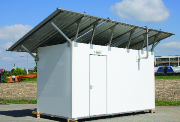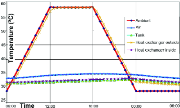 Field-based process analysers are becoming smaller and more cost effective. However, cooling their environmental protection shelters can be problematic. Martin Hess of Intertec makes the case for passive cooling
Field-based process analysers are becoming smaller and more cost effective. However, cooling their environmental protection shelters can be problematic. Martin Hess of Intertec makes the case for passive cooling
Many field-based process analysers are sited in hostile desert environments. Here, they will need protection against dust and sand storms, as well as high daytime temperatures. For optimum performance and reliability, their electronics and sample conditioning systems must be maintained within prescribed temperature limits, meaning the environmental protection shelter must be well insulated and have some form of cooling.
Most analyser shelters currently use air conditioning (AC) systems to protect against high temperatures. These are expensive – especially if they need to be explosion-proof – and can account for a high percentage of the capital, energy and maintenance costs of a typical oil or gas analyser installation. Furthermore, they do not easily scale down to suit small shelters, and their performance decreases by as much as two thirds at high ambient temperatures.
One nascent trend is to employ passive cooling technology. Originally developed for pipeline instrumentation shelters in remote desert locations without an electricity supply, passive cooling systems (PCSs) have been deployed very successfully over the past decade. Intertec, for example, has supplied passively cooled shelters for protecting SCADA systems on numerous pipeline projects, which have become renowned for reliable, low maintenance operation.
Despite this take-up, analyser system integrators may be unaware that the performance and choice of PCSs has increased significantly in recent years. Common misconceptions are that they are big, demand high capacity coolant tanks, and are only suitable for climates with large day-night temperature swings. Nowadays, however, there is a variety of passive and hybrid-passive cooling technology that can be scaled to suit most analyser and micro-analyser installations, and used in virtually any climate.
Pure passive
A purely passive cooling system works by exploiting the difference between day and night temperatures in regions with high swings, such as arid deserts. Shelters (Figure 1) typically comprise an insulated housing with internal and external heat exchangers – the latter is roof-mounted and incorporates a sunshade – together with a thermally stratified heat storage tank and interconnecting pipework forming two closed-loop thermosiphon systems (external and internal). Water is normally used as the coolant because of its high thermal capacity, and circulates by natural convection. The process is inherently reliable because there are no moving parts.
During the day no thermosiphon circulation occurs in the external circuit because the external heat exchanger is higher than the storage tank and contains water which is hotter and therefore less dense. However, thermosiphon circulation causes cold water to be displaced from the bottom of the tank and drawn up through the internal circuit/heat exchanger, cooling the shelter interior by air convection.
At night, water in the external heat exchanger becomes colder than that in the tank, causing circulation. The heat energy stored in the tank is dissipated to the environment by the external heat exchanger, while the internal circuit continues operating normally. This process consumes no energy, and smooths temperature peaks and troughs over 24 hours.
Figure 2 shows the temperature profiles of a test shelter built by Intertec to compare different cooling technologies. With a footprint of 2.4 x 5.4m, the 3m high shelter is constructed from panels with twin 4mm walls in the company’s low thermal conductivity GRP material, sandwiching a 76mm PU foam core. The heat dissipation of equipment inside the shelter is 1kW, and the ambient 29°C night and 58°C day temperatures represent worst-case summer values in the UAE. Good insulation ensures that internal temperature is barely affected by the high daytime ambient, and passive cooling keeps its maximum to within 7°C of the ambient temperature of the preceding night.
Key parameters to consider when configuring a PCS are the heat dissipation of the equipment, maximum permissible temperature inside the shelter, the outside air temperature of the night preceding the hottest day, and the difference between night and day temperatures. System performance is limited by the sum of the temperature differences, or delta-T, which must be at least 6K for natural convection. If the delta-T is too small, however, forced circulation offers a cost-effective solution.

Forced circulation
Forced circulation effectively doubles PCS performance, allowing operation with a delta-T of just 3K, and can be realised using small low-power pumps driven by a rechargeable battery and solar panel. Another major benefit is that water can be routed via heat conduction manifolds instead of an internal water/air heat exchanger. As thermal conduction is about five times more effective at heat transfer than air convection, direct cooling of manifold-mounted analyser electronics is considerably more efficient than using AC to circulate cooled air, reducing cooling requirements by as much as 80%. This lowers capital and operating costs dramatically, and decreases shelter sizes.
Hybrid passive/active
One method of cooling analyser shelters that is gaining ground involves a hybrid system. Pioneered by Intertec, this combines a passive cooler with a small external water chiller that only operates on demand, to further reduce the water temperature in the heat
storage tank. It is, however, also possible to build hybrid systems to exploit cool water from any available nearby source, provided its temperature is at least 3K lower than the shelter’s maximum allowable internal temperature. The chiller forms part of a closed-loop system, feeding a heat exchanger coil in the bottom of the tank (Figure 3).
Designers can easily scale cooling capacity to the application. The passive element can be sized so that in winter its cooling power is sufficient to maintain internal shelter temperatures, while in summer months when the ambient night time temperature is too high, the chiller can be switched on by a thermostat until the tank water is cool enough (a timer ensures it only operates at night). Intertec’s test results show that hybrid cooling with a 1kW chiller ensures that the test shelter’s internal temperature never exceeds 27°C, even after the hottest night. The chiller’s capital costs are much less than an AC system, and its energy consumption is about 30% lower because it does not have to run when ambient temperature is very high.
Hybrid cooling systems also offer increased reliability and reduced maintenance costs, through built-in redundancy. In the event of chiller failure or power loss – even at the hottest time of year – the tank’s cold water will keep the shelter below the night time temperature for two successive days. Provided the analyser electronics are backed by an uninterruptible power supply, they can operate normally throughout this period. On the other hand, equipment cooled by conventional AC invariably has to be shut down or revert to a low power mode with limited functionality immediately cooling ceases, to prevent overheating. The fault then needs to be rectified very quickly, which carries high cost overheads.

The bottom line
Shelters with passive or hybrid cooling systems incur slightly higher capital costs than those with AC. As an example, the total cost of a passively cooled version of Intertec’s test shelter is approximately 20% higher than a similar shelter with AC, while a test shelter with hybrid cooling costs about 28% more. However, by far the most important parameter for analyser installations in remote locations is long term cost of ownership (LTCO).
While a PCS has very low maintenance requirements and requires no power, in extreme environments such as the UAE or Saudi Arabia, the shelter’s temperature could reach 39°C – permissible for electronics but uncomfortable for personnel. A hybrid cooling system capable of maintaining the shelter at 25°C under the same conditions would have a power consumption of about 5,800 kWh/year, whereas an AC system of comparable performance would consume over 13,000 kWh/year, require regular maintenance and be susceptible to breakdown at peak temperatures.
System integrators seeking a reliable, scalable and cost-effective long term solution for protecting analyser equipment against high temperatures should take a careful look at passive cooling technology.
Intertec Instrumentation
T: 0800 756 1102
